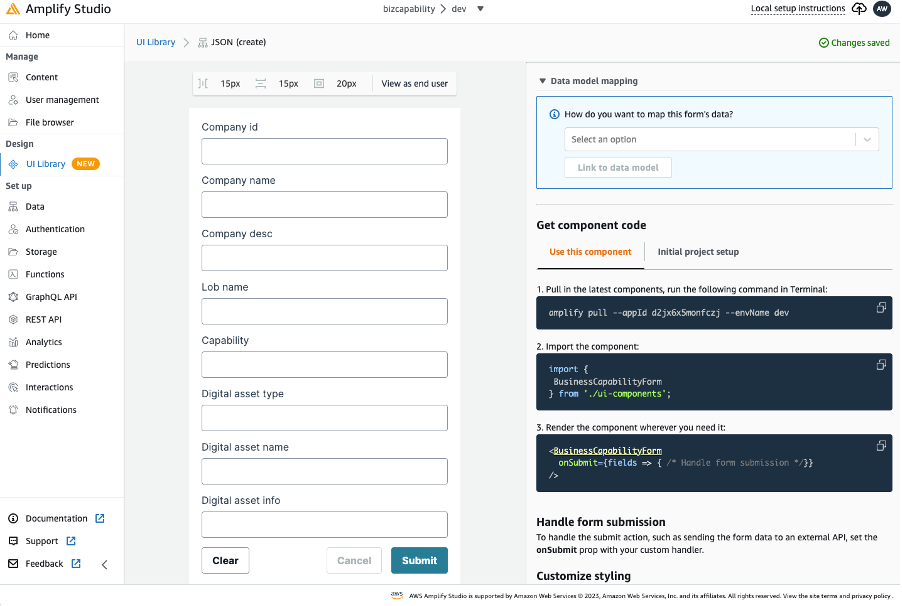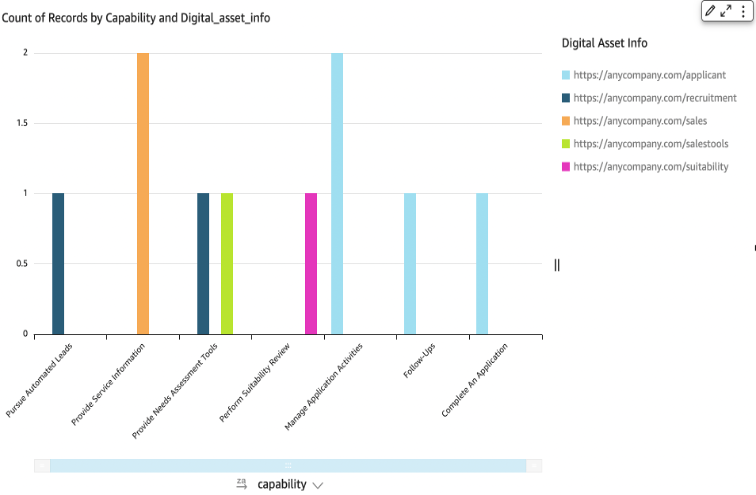AWS Business Intelligence Blog
Build and share a business capability model with Amazon QuickSight
 |
All your trusted BI capabilities of Amazon QuickSight now come with powerful new AI features that integrate chat agents, deep research, and automation in one seamless experience with Amazon Quick Suite! Learn more » |
The technology landscape has been evolving rapidly, with waves of change impacting IT from every angle. It is causing a ripple effect across IT organizations and shifting the way IT delivers applications and services.
The change factors impacting IT organizations include:
- The shift from a traditional application model to a services-based application model (SaaS, PaaS)
- The shift from a traditional infrastructure and hardware costing model to cloud-based containers (private and public clouds) with metered usage for resources (IaaS)
- The shift from the lengthy traditional development and delivery cycles to continuous development and integration (DevOps)
- The shift in application architecture from N-Tier to loosely coupled services
The portfolio of services delivering business capabilities are the new assets of IT organizations that need to be cataloged in a repository. The system must follow a well-defined business taxonomy that enhances discovery, analysis, and reuse by potential consumers, and avoids building redundant services. The traditional portfolio management tools within the organization need to be augmented with additional components that can manage the complexity of the services ecosystem.
This post provides a simple and quick way of building an extendable analytical system using Amazon QuickSight to better manage lines of business (LOBs) with a detailed list of business capabilities and APIs, deep analytical insights, and desired graphical visualizations from different dimensions. In addition, this tool enhances the discovery and reuse of existing business capabilities, avoids duplication of services, and shortens time-to-market.
Use case overview
Bob is a Senior Enterprise Architect. He recently joined a Tier 1 bank. His first assignment is to assess the bank’s capabilities to offer new financial products to its high-value retail clients. The only document given to Bob was PowerPoint slides and the names of the head of each department to get more information. The PowerPoint presentation provided high-level information, but it didn’t give an insight into how capable each department is to provide the required data through APIs for the new products. To collect that information, Bob gets in touch with the head of each department, who in turn refer him to their development leads, who in turn give him a bunch of technical documents that explain how APIs are being used.
Relevance
Business analysts are familiar with business terminology and taxonomy, and often depend on the technology team to explain the technical assets associated with business capabilities. The business capabilities are the assets of the IT organization that need to be cataloged in a repository. The catalog must follow a well-defined business taxonomy that enhances discovery and reuse by consumers, and avoids building redundant services.
The better organized the catalog is, the higher the potential for reuse and the return on investment for the services transformation strategy. The catalog needs to be organized using some business functions taxonomy with a detailed list of capabilities and sub-capabilities. The following diagram illustrates an example of services information and interdependencies.

Defining and capturing a business capability model
If an enterprise doesn’t have a system to capture the business capability model, consider defining and finding a way to capture the model for better insight and visibility, and then map it with digital assets like APIs. The model should be able to showcase to LOBs their categories and capabilities. The following table includes some sample LOBs and their associations for a business that sells the services.
|
LOB |
Category |
Capability |
|
Recruitment |
Manage Applicant Experience |
Manage Application Activities |
|
Process Application |
Follow-Ups |
|
|
Pursue Automated Leads |
||
|
Sale Service |
Engage Customer |
Provide Needs Assessment Tools |
|
Provide Service Information |
After the map is defined and captured, each business capability can be mapped to APIs that are implemented for it. Each business capability then has visibility into all the associated digital assets and mapped metadata of the services, such as consumers of the API.
To capture the model, you can define a simple table to capture the information, and then you can perform further analysis on it with an analytical tool such as QuickSight.
In the following sample data model, each business LOB has several business categories and capabilities, and each capability can be mapped to multiple APIs. Also note that there’s not always a 1:1 mapping between a business capability, an API, and a service.
- Business LOB – Recruitment, Sale Service
- Business category – Process Application, Engage Customer
- Business capabilities – Complete an Application, Follow-Ups
- Digital assets – Recruitment API, Sale Service API
There are sets of other standard information that you can include in a data model, such as API consumers.
The following example shows a table structure to capture this information.

The following figure visualizes the business capabilities and associated APIs.

The remainder of the post highlights the key components to build the full solution end to end. The UI captures the business capabilities and associated APIs, and publishes the service information through a DevOps process. The solution also includes storage and a reporting tool that complement the applications portfolio management capability in place and expand its capabilities with the services portfolio.
Aligning APIs to a business capability model
To align APIs to a business capability model, you can follow these steps:
- Understand the business capabilities – Identify the key business capabilities of your organization and understand how they support the overall business strategy.
- Map the APIs to the capabilities – Review the existing APIs and map them to the corresponding business capabilities. This will help identify any gaps in the capabilities that can be addressed through new or updated APIs.
- Prioritize the APIs – Prioritize the development of new or updated APIs based on their importance to the business capabilities. This will ensure that the most critical capabilities are supported by the APIs.
- Implement governance – Implement a governance process to ensure that the APIs are aligned with the business capabilities and are used correctly. This can include setting standards for how the APIs are designed, developed, and deployed.
- Monitor and measure – Monitor the usage and performance of the APIs to measure their impact on the business capabilities. Use this information to make decisions about changes to the APIs over time.
- Regularly review and update – Review and update the mapping of the APIs to the business capabilities on a regular basis to ensure they remain aligned with the organization’s goals and objectives.
Maintenance and evolution of a business capability model
Building a business capability model is not a one-time exercise. It keeps evolving with business requirements and usage. Data management best practices should be followed as per your company’s guidelines to have consistent data end to end.
Solution overview
In this section, we introduce the ability to capture the business capabilities and associated APIs and make them available using the QuickSight business intelligence (BI) tool, and highlight its features.
The following approach provides the ability to manage business capability models and enable them to link business capabilities with enterprise digital assets, including services, APIs, and IT systems. This solution enables IT and business teams to further drill down into the model to see what has been implemented. These details provide value to architects and analysts to assess which services can be combined to provide new offerings and shorten time-to-market, enable reusability by consumers, and avoid building redundant services.
The following key components are required:
- Reporting tool – Amazon QuickSight
- Query service – Amazon Athena
- Serverless web application – This includes the following:
- Front end – AWS Amplify
- API – AWS AppSync
- Database – Amazon DynamoDB
- Authentication – Amazon Cognito
Organizations can use their existing UI framework (if available) to capture the information, or they can use one of the open-source services available in the market. Depending on the selection and capability of the open-source product, a user interface can be generated and customized.
Let’s look at each service in our solution in more detail:
- Amplify – Amplify is a set of tools and services that can be used together or on their own, to help front-end web and mobile developers build scalable full stack applications, powered by AWS. With Amplify, you can configure app backends and connect your app in minutes, deploy static web apps in a few clicks, and easily manage app content outside the AWS Management Console. Amplify supports popular web frameworks including JavaScript, React, Angular, Vue, and Next.js, and mobile platforms including Android, iOS, React Native, Ionic, and Flutter. Get to market faster with AWS Amplify.
- AppSync – AWS AppSync simplifies application development by creating a universal API for securely accessing, modifying, and combining data from multiple sources. AWS AppSync is a managed service that uses GraphQL so that applications can easily get only the data they need.
- Athena – Athena is an interactive query service that makes it easy to analyze data directly in Amazon Simple Storage Service (Amazon S3) using standard SQL. In this solution, we use Athena as a data source for QuickSight.
- Amazon Cognito – Amazon Cognito delivers frictionless customer identity and access management (CIAM) with a cost-effective and customizable platform. It easily connects the web application to the backend resources and web services.
- DynamoDB – DynamoDB is a fully managed, serverless, key-value NoSQL database designed to run high-performance applications at any scale. DynamoDB offers built-in security, continuous backups, automated multi-Region replication, in-memory caching, and data import and export tools.
- QuickSight – QuickSight is a serverless, cloud-based BI and reporting service that brings data insights to your teams and end-users through machine learning (ML)-powered dashboards and data visualizations, which can be accessed via QuickSight or embedded in apps and portals that your users access.
The following diagram illustrates the solution architecture.

In the following sections, we walk through the implementation and end-to-end integration steps.
Build a serverless web application with Amplify
The open-source Amplify provides a CLI, libraries, UI components and Amplify hosting to build full stack iOS, Android, Flutter, Web, and React Native apps. For instructions on building a serverless web application, refer to the following tutorial. For this post, we created the following GraphQL schema with amplify add api:
After we use Amplify to deploy the API in the cloud, a corresponding AppSync API and a DynamoDB table are created automatically.
You can use the Amplify UI library to generate a business capability intake form and bind the fields to your front-end code.

You can add authentication to your application using Amazon Cognito by running amplify add auth.
With that, you are now hosting a serverless web application for your business capabilities securely and at scale.
Set up Athena and the Athena DynamoDB data connector
The DynamoDB table generated by Amplify stores all the business capabilities. You can set up Athena and the Athena DynamoDB data connector so that you can query your tables with SQL. For more information, refer to Amazon Athena DynamoDB connector.
Enable QuickSight
Enable QuickSight in your AWS account and create the datasets. The source dataset is the Athena database and table that you created earlier. To connect, you need to allow access to query Athena and Amazon S3 via the admin user interface in QuickSight. Refer to accessing AWS resources for access requirements.
Sample reports
When all the components are up and running, you can design analyses and generate reports. For more information about gathering insights from the captured data, refer to Tutorial: Create an Amazon QuickSight analysis. You can export reports in PDF, and share analyses and reports with other users. The following screenshots are reports that reflects the relationship among LOBs, business capabilities, and APIs.
The first screenshot visualizes the capabilities and associated APIs. This enables the user to identify a set of APIs, and use the same API in new similar business functions.

The following screenshot visualizes LOBs, category, and capabilities. This enables the user to easily gain insights on these relationships.

Best practices
The following are some best practices for business capability modeling:
- Define clear and measurable capabilities – Each capability should be defined in a way that is clear and measurable, so that it can be tracked and improved over time.
- Involve key stakeholders – Involve key stakeholders in the modeling process to ensure that the capabilities accurately reflect the needs of the organization.
- Use a consistent framework – Use a consistent framework to ensure that capabilities are defined and organized in a way that makes sense for the organization.
- Regularly review and update – Review and update the capabilities regularly to ensure they remain relevant and aligned with the organization’s goals and objectives.
- Use visual representations – Use visual representations, like diagrams or models, to help stakeholders understand and communicate the capabilities.
- Implement a governance process – Implement a governance process to ensure that the capabilities are being used correctly and to make decisions about changes to the capabilities over time.
Conclusion
In this post, you learned how to build a system to manage a business capability model, and discover and visualize the results in QuickSight.
We hope that companies can use this solution to manage their enterprise capability model and enable users to explore business functions available for them to use within the organization. Business users and technical architects can now easily discover business capabilities and APIs, helping accelerate the creation and orchestration of new features. With the QuickSight web interface, you can filter through thousands of business capabilities, analyze the data for your business needs, and understand the technical requirements and how to combine existing technical capabilities into a new business capability.
Furthermore, you can use your data source to gain further insights from your data by setting up ML Insights in QuickSight and create graphical representations of your data using QuickSight visuals.
To learn more about how you can create, schedule, and share reports and data exports, see Amazon QuickSight Pixel-Perfect Reports.
About the authors
 Abdul Qadir is an AWS Solutions Architect based in New Jersey. He works with independent software vendors in the Northeast and provides customer guidance to build well-architected solutions on the AWS cloud platform.
Abdul Qadir is an AWS Solutions Architect based in New Jersey. He works with independent software vendors in the Northeast and provides customer guidance to build well-architected solutions on the AWS cloud platform.
 Sharon Li is a solutions architect at AWS, based in the Boston, MA area. She works with enterprise customers, helping them solve difficult problems and build on AWS. Outside of work, she likes to spend time with her family and explore local restaurants.
Sharon Li is a solutions architect at AWS, based in the Boston, MA area. She works with enterprise customers, helping them solve difficult problems and build on AWS. Outside of work, she likes to spend time with her family and explore local restaurants.